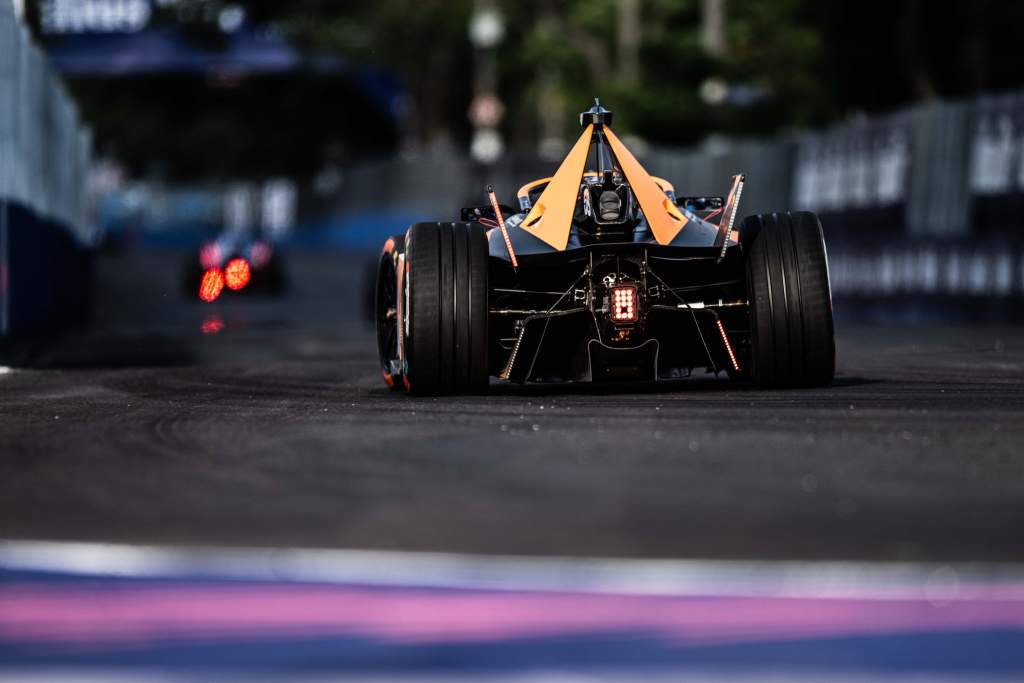The Formula E rookie tests have always been eclectic affairs so far with drivers spanning endurance racing – Nicolas Lapierre, Felipe Albuquerque and Pipo Derani – to former and future F1 drivers such as Paul di Resta and Antonio Giovinazzi.
The class of 2023 is no different with the world of sportscars being represented via Jota’s Yifei Ye and now Charlie Eastwood who today has been confirmed as an entry for the NEOM McLaren squad.
In a sense, the test is staying true to its healthy variety of drivers combined on a single day of running. But perhaps the names of Red Bull junior Zane Maloney, Alpine protege Victor Martins, 2020 ADAC Formula 4 champion Jonny Edgar and now McLaren’s second confirmed driver, Luke Browning, are more meaningful as future strata of drivers that will be racing in Formula E when the next generation of cars arrives in 2026.
There is absolutely no suggestion that those four drivers will not make it to Formula 1, but by 2026 they will know if the significant odds to make it to the hallowed tarmac of Grand Prix racing have been beaten or not.
Those odds are stacked against them and a little corner of either their own brain, or that of their management, will be thinking about a professional career away from the pinnacle for the future too.

That is why Maloney (19), Edgar (19), Browning (21, above) and Martins (21) are putting themselves in an early position to get an equivalent of a solid and lucrative trade in Formula E under their belts so that teams will reference and place them on their radar for when the likes of Sam Bird, Sebastien Buemi, Andre Lotterer, Jean-Eric Vergne and Edoardo Mortara slip off their current grandee status.
Browning, a British F4 and GB3 champion racing in FIA F3 this year, said on being announced at NEOM McLaren for the Berlin test that he was “grateful for the opportunity to gain some experience in very different machinery than usual.
“I’ll be looking to pick up as much as I can from the successful and experienced team I will be surrounded by. It will be a different style of driving compared to what I’m used to – I don’t doubt I have a lot to learn, but I’m eager to pick it up as quickly as possible.”
Team principal, Ian James and team manager Gary Paffett should be commended for choosing both Browning and Eastwood. They’ll get an insight into one of the UK’s most exciting talents of his generation, and an experienced professional who has worked exhaustively with a major manufacturer (Aston Martin) on a variety of programmes.
James described the test as “a good way for us as teams to give talent the opportunity to get a taste of the Gen3 machinery, while being able to evaluate them at the same time.
“Our line-up is an exciting combination of Charlie (pictured below), who we’ve been working closely together with for a while now, and Luke, who is an emerging talent. It will be great to see both of them out on track.

“It’s good to see significant interest in the series, from both up-and-coming talent, as well as established drivers.”
Currently the average age of Formula E drivers is 30 years and six months. With only Sacha Fenestraz, Maximilian Guenther, Sergio Sette Camara and Dan Ticktum under the age of 26, there is need for a youth injection in Formula E but some teams still seem hesitant to invest.
Yet, it was interesting to see rookies Fenestraz and Jake Hughes starting new rules set off so vibrantly so far in 2023. Several rival senior team personnel took note. Both had taken part in the last rookie test in 2020. Three years on, along with Nick Cassidy and Sette Camara they had race deals and some rewarding salaries.
The structure of a driver’s career still appears to be oddly uncharted beyond the expensive, ambitious but wholly understandable pursuit of the F1 fantasy.
History will repeat itself for at least one of the 2023 rookie test drivers in some capacity. While others focus and dream, with emphasis on the dream in F1, others are covering some bases. That is eminently sensible but bafflingly rare.






